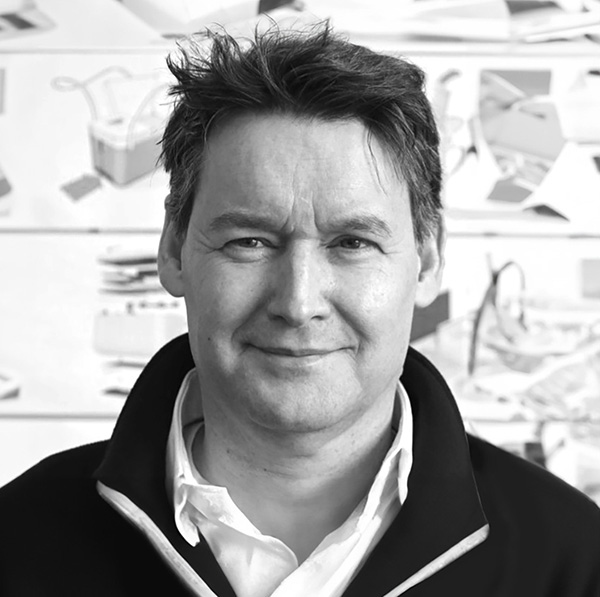Photography: SLIMDESIGN
How are things going at SLIMDESIGN?
Wouter: “The agency is doing well; interesting projects are coming in and clients seem to find us more easily. We are pleased that we are in a position where we can select the most interesting projects from clients with a similar drive and ambition. We enjoy projects where the client challenges us to find innovations that help them stand out from the competition. We aim to create new and unique products that provide real benefits to the end user.”

Photo: designers at work | Photography: SLIMDESIGN
Have your methods evolved since you started 20 years ago?
“I feel that projects are running more smoothly these days. We’ve put a lot of effort into refining our design process. For example, we now develop physical, digital, and UX elements simultaneously. We do this by deploying a multidisciplinary team made up of design (both industrial and UX), engineering (mechanical and electrical), and software experts (firmware, applications, and back-end). This integrated approach helps us move faster, as everyone is involved at every stage, and the optimum solution is found through input from all disciplines.”
What do you think draws clients to work with SLIMDESIGN?
“Many of our clients stay with us over the long term because we are fully transparent (provide access to our documents), work efficiently, and only do things that add value. We like to cooperate and happily include the client’s personnel and their partners in the project. It also helps that we created clear and well-defined phases, with fixed budgets.”

Photo: Building functional & aesthetic prototypes | Photography: SLIMDESIGN
Can you walk us through SLIMDESIGN’s approach and development process?
“Sure! Our process is broken down into five key phases. Our process begins with Strategy Research & Innovation, identifying opportunities and translating them into validated product ideas. A Feasibility & Kick Start Study defines technical requirements, costs, and market fit, ensuring realistic project foundations. In the Prototype Phase, we quickly test core functionalities to reduce risks, followed by the Development Phase, where refined prototypes are engineered for validation. Finally, we have Implementation Support, overseeing production, tooling, certification, and manufacturing to deliver high-quality products on time and within budget.”

Photo: Bringing Panasonic Nubo products into production | Design: SLIMDESIGN
Are there any special projects you’re currently working on?
“Yes, we’re involved in several exciting projects right now. For Samsung, we prototyped the ‘TV of the future’, exploring new screen interactions and seamless technology integration. For Fujitsu, we created a compact laptop tailored to Japan’s smaller living spaces, taking it from research to production. XIM reimagined powder-based nutrition with precise dispensing and smooth, grit-free drinks. We delivered functional cosmetic prototypes within five months. Our internal start-up PhoneCam, a wearable AI-powered body camera, connects to phones for real-time support. Combined with our intuitive PhoneCam app, this device provides real-time support and remote safety assistance. It’s a product with enormous potential, and it’s getting attention from major companies like Microsoft and HP. It’s one of those projects that really makes me excited about how technology can improve lives.”
How do you balance creative freedom and commercial feasibility within projects?
“The creative side of our work is all about coming up with new ideas, solving design challenges, and pushing existing technologies to their limits. But we always ensure that our solutions are feasible and add real value for the end user. At SLIMDESIGN, we believe in minimalism, not just in design but in the way we approach problems.”
“We believe in minimalism, not just in design but in the way we approach problems.”
– Wouter Konings, founder SLIMDESIGN
Where do you find inspiration and how do you stay on top of the latest tech trends?
“We visit major trade shows like CES in Las Vegas and IFA in Berlin, which showcase the latest innovations and give us the chance to meet with clients. We also conduct a lot of technology research and product teardowns to understand how others have solved mechanical challenges. Additionally, we have strong relationships with suppliers and tech experts, which keeps us informed on the latest advancements.”

Photo: Laptop for the Japanese market | Photography: FUJITSU
Looking to the future, what impact do you hope your agency will have?
“We aim to help our clients create products that are better than what the competition is offering and potentially improve the lives of many. We also focus on sustainability – we strive to reduce energy consumption, maximize product lifespan, and improve repairability. But the downside of our work: the best sustainability is simply not buying something new unless it's really needed.”
What do you see as the biggest opportunities and threats?
“Asian companies are advancing rapidly, and AI can now create beautiful visuals with minimal input. However, we believe that experienced designers are still essential for making the right decisions throughout the design process. Designers bring cultural insights and innovation opportunities to the table. We have the expertise and creativity to blend all these requirements into a meaningful, beautiful product. This allows us to continue adding value and doing what we love in the future.”
And last of all, why did you become a BNO mentor?
“We enjoy sharing our experience and knowledge to help other companies and designers. They can always reach out via email for advice on a project, mentor questions, or even to request a guest lecture. If anyone wants to visit us or have an informal chat, we invite them to join our 'frimibo' (Friday afternoon drinks).”
|
With an impressive background in design, Wouter Konings has worked with renowned companies such as Dyson, Philips and a leading design consultancy before founding his own studio in 2003. As a BNO Mentor, he shares his knowledge and experience to guide and inspire upcoming designers. His mission is to deliver genuine added value by applying his expertise in developing consumer electronics. |
 Photo: Wouter Konings | Photography: SLIMDESIGN
Photo: Wouter Konings | Photography: SLIMDESIGN